
Know Before You Go


Marine Iguana Facts | Galapagos Islands Wildlife Guide
These large, harmless creatures were called “hideous” by Charles Darwin, as they are probably among the most grotesque-looking reptiles. However, they were an important species in helping Darwin form his theory of evolution by natural selection.
Physical Characteristics
Males are 4.5 feet in length and can weigh a little more than 3 pounds
Females can be almost 3 feet and weigh about 1 pound
Skin is blackish, which can change to coppery greens and reds in males during breeding season. The males on Española Island are colorful year-round
A row of spines covers the entire length of their backs
Blunt noses help them graze on seaweed
Flat tails help them swim
Range and Habitat
Marine iguanas are the only seagoing lizards in the world, and they are found on the rocky shores of most of the Galapagos Islands. In fact, they range only in the Galapagos. The absence of mammalian predators has helped them adapt well to a marine environment. Because the water surrounding the islands can be quite cold, and they are ecothermic creatures, they come ashore often to warm up. They live in colonies near shallow reefs and rocky coastlines.
Behavior and Communication
Marine iguanas are most active during the day, that is, after spending the first few hours of the day sunbathing and preparing for the day’s activities.
Feeding Habits
Marine iguanas are herbivores and feed mainly on intertidal seaweed and algae during low tide. When feeding, the larger iguanas, which can retain more body heat, may remain submerged in the water for up to one hour.
Iguanas tend to intake a large amount of sodium, which can be toxic to them. To accommodate this, they excrete salt crystals by sneezing a lot.
Breeding and Reproduction
Breeding occurs at different times on different islands, but generally individuals breed once every two years. Mating season is January through April, depending on the island. They are colonial, often seen piling atop one another. When breeding, the larger males become territorial and aggressive, butting and pushing against rivals. They tend to want to conserve energy, so they may bite only to defend their territory.
Mated females lay one to six eggs in a sandy nest or volcanic ash burrow that is 1,000 feet inland. Females guard the nest fiercely for several days but then leave the eggs while they finish incubating, which takes approximately 95 days. Hatchlings are not given any parental protection.
Conservation
Marine iguanas are vulnerable, but since the creation of the Galapagos Marine Reserve in 1998, their status has somewhat improved. Their primary predators are birds, such as hawks, owls and herons when they are young, and the Galapagos hawk when they are adults. And they are also threatened by introduced cats, rats, dogs and pigs. In addition, El Niño events can be devastating, causing as many as 70 percent of the population to die in one year due to famine conditions.
Efforts made through the Charles Darwin Research Station to measure the iguanas’ corticosterone levels—basically, adrenaline—helps monitor the general health of the marine iguana population. Their stress increases dramatacially during El Niño years, and it decreases during La Niña when there is more food to feast on. It also increases when there is more human activity in their environment. When stress increases, there are many more complications with reproduction, such as eggs not being fertilized or few eggs being laid.Header Credit: Roberto Plaza
See Marine Iguanas on These Galapagos Adventures

Galapagos Discovery: The Nat Hab Experience
Small-group adventures aboard your choice of private yachts, led by our outstanding naturalist guides and photography pros. Snorkel and swim with sea lions, sea turtles and penguins on this incomparable nature odyssey.































